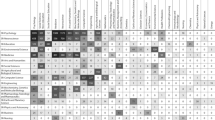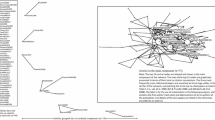Abstract
This paper finds its origins in a multidisciplinary research group’s efforts to assemble a review of research in order to better appreciate how “spatial reasoning” is understood and investigated across academic disciplines. We first collaborated to create a historical map of the development of spatial reasoning across key disciplines over the last century. The map informed the structure of our citation search and oriented an examination of connection across disciplines. Next, we undertook a network analysis that was based on highly cited articles in a broad range of domains. Several connection gaps—that is, apparent blockages, one-way flows, and other limitations on communications among disciplines—were identified in our network analysis, and it was apparent that these connection gaps may be frustrating efforts to understand the conceptual complexity and the educational significance of spatial reasoning. While these gaps occur between the academic disciplines that we evaluated, we selected a few examples for closer analysis. To illustrate how this lack of flow can limit development of the field of mathematics education, we selected cases where it is evident that researchers in mathematics education are not incorporating the important work of mathematicians, psychologists, and neuroscientists—and vice versa. Ultimately, we argue, a more pronounced emphasis on transdisciplinary (versus multidisciplinary or interdisciplinary) research might be timely, and perhaps even necessary, in the evolution of educational research.







Similar content being viewed by others
Notes
Because this writing is concerned with research within and communications among a number of disciplines, we have adopted the convention of capitalizing the names of those disciplines whenever we refer to recognized domains of inquiry. This convention is useful to distinguish between, for example, the field of Mathematics and the activity of learning mathematics.
As the focus of this article is transdisciplinarity, illustrated through the instance of spatial reasoning, it is beyond our current purposes to critique or elaborate this preliminary definition. However, we have done so elsewhere. See, in particular, the closing chapter of Davis, Francis, and Drefs (2015).
All journals within the Scopus database are classified in one or more major and minor subject areas. Neuroscience, Mathematics, and Psychology are each considered major subject areas. Education is a minor subject area within Social Sciences. Mathematics Education journals are typically classified under the major subjects of Mathematics and Social Sciences and under the minor subjects of Education and Applied Mathematics, respectively.
Available through: http://www.wncp.ca/.
References
Ansari, D., & Coch, D. (2006). Bridges over troubled waters: Education and cognitive neuroscience. Trends in Cognitive Sciences, 10(4), 146–151.
Baars, B.J. (1995). Can physics provide a theory of consciousness? A review of Shadows of the Mind by Roger Penrose. Psyche, 2(8). Retrieved from http://horizons-2000.org/5.%20Mind%20and%20Metaphysics/Web%20papers/Bernard%20Baars,%20Review%20of%20Shadows%20of%20the%20Mind.htm
Bishop, A. J. (1980). Spatial abilities and mathematics education—A review. Educational Studies in Mathematics, 11(3), 257–269. Retrieved from http://www.jstor.org/stable/3481801
Blair, K. P., Rosenberg-Lee, M., Tsang, J. M., Schwartz, D. L., & Menon, V. (2012). Beyond natural numbers: Negative number representation in parietal cortex. Frontiers in Human Neuroscience, 6(7), 1–17.
Borgatti, S. P., Mehra, A., Brass, D. J., & Labianca, G. (2009). Network analysis in the social sciences. Science, 323, 892–895. doi:10.1126/science.1165821
Bruce, C., Davis, B., Sinclair, N., and the Spatial Reasoning Study Group. (2015). A transdisciplinary review of research into spatial reasoning. Report to Social Sciences and Humanities Research Council of Canada.
Bruce, C., Moss, J., Sinclair, N., Whiteley, W., Okamoto, Y., McGarvey, L., & Davis, B. (2013). Early-years spatial reasoning: Learning, teaching, and research implications. In B. Davis (Ed.), Linking research and practice. Symposium conducted at the meeting of the NCTM research presession, Denver, CO.
Butterworth, B. (1999). The mathematical brain. New York: Macmillan.
Bryant, P. E. (2008). Paper 5: Understanding spaces and its representation in mathematics. In T. Nune, P. Bryant, & A. Watson (Eds.), Key understandings in mathematics learning: a report to the Nuffeld Foundation. Retrieved 28.04.2013 from http://www.nuffeldfoundation.org/sites/default/files/P5.pdf.
Choi, B. C., & Pak, A. W. (2006). Multidisciplinarity, interdisciplinarity and transdisciplinarity in health research, services, education and policy: 1. Definitions, objectives, and evidence of effectiveness. Clinical and Investigative Medicine. Medecine Clinique et Experimentale, 29(6), 351–364.
Christodoulou, J. A., & Gaab, N. (2008). Using and misusing neuroscience in education-related research. Cortex, 45, 555–557.
Clements, D. H., Battista, M. T., & Sarama, J. (2001). Logo and geometry. Journal for research in mathematics education monograph series, 10. Reston: National Council of Teachers of Mathematics.
Coles, A. (2014). Transitional devices. For the Learning of Mathematics, 34(2), 24–30.
Davis, B., Francis, K., & Drefs, M. (2015). A history of the current curriculum. In B. Davis & the Spatial Reasoning Study Group (Eds.), Spatial reasoning in the early years: principles, assertions, and speculations (pp. 47–62). New York: Routledge.
Davis, B., & Spatial Reasoning Study Group (Eds.). (2015). Spatial reasoning in the early years: principles, assertions, and speculations. New York: Routledge.
Dehaene, S. (2011). The number sense: How the mind creates mathematics. Cambridge: Oxford University Press.
Frick, A., Möhring, W., & Newcombe, N.S. (2014). Picturing perspectives: development of perspective-taking abilities in 4- to 8-year-olds. Frontiers in Psychology, 5. doi:10.3389/fpsyg.2014.00386
Fu, T. Z. J., Song, Q., & Chiu, D. M. (2014). The academic social network. Scientometrics, 101, 203–239. doi:10.1007/s11192-014-1356-x
Galton, F. (1880). Visualised numerals. Nature, 21, 43–74.
Gattegno, C. (1965). Mathematics and imagery. Mathematics Teaching, 3(4), 22–24.
Hegarty, M., & Waller, D. (2005). Individual differences in spatial abilities. In P. Shah & A. Miyake (Eds.), The Cambridge handbook of visuospatial thinking (pp. 121–169). Cambridge: Cambridge University Press.
Khan, S., Francis, K., & Davis, B. (2015). Accumulation of experience in a vast number of cases: Enactivism as a fit framework for the study of spatial reasoning in mathematics education. ZDM, 47(2), 269–279. doi:10.1007/s11858-014-0623-x
Lakoff, G., & Núñez, R. E. (2000). Where mathematics comes from: How the embodied mind brings mathematics into being. New York: Basic Books.
Lattanzi, M. (1998). Transdisciplinarity: Stimulating synergies, integrating knowledge. UNESCO. Retrieved June 5, 2016, from http://unesdoc.unesco.org/images/0011/001146/114694eo.pdf
Lyons, I., & Beilock, S. (2011). Numerical ordering ability mediates the relation between number-sense and arithmetic competence. Cognition, 121(2), 256–261.
Lyons, I., Price, G., Vaessen, A., Blomert, L., & Ansari, D. (2014). Numerical predictors of arithmetic success in grades 1–6. Developmental Science, 17(5), 714–726.
McGarvey, L. (2012). What is the pattern? Criteria used by teachers and young children. Mathematical Thinking and Learning, 14(4), 310–337.
McManus, I. C. (2005). Symmetry and asymmetry in aesthetics and the arts. European Review, 13(Supplement 2), 157–180. doi:10.1017/S1062798705000736
Moss, J., Hawes, Z., Naqvi, S., & Caswell, B. (2015). Adapting Japanese lesson study to enhance the teaching and learning of geometry and spatial reasoning in early years classrooms: A case study. ZDM, 47(3), 377–390.
Mottron, L., Dawson, M., & Soulières, I. (2009). Enhanced perception in savant syndrome: patterns, structure and creativity. Philosophical Transactions of the Royal Society, B: Biological Sciences, 364(1522), 1385–1391. doi:10.1098/rstb.2008.0333
Mulligan, J., & Mitchelmore, M. (2009). Awareness of pattern and structure in early mathematical development. Mathematics Education Research Journal, 21(2), 33–49. doi:10.1007/BF03217544
Mulligan, J. T., & Mitchelmore, M. C. (2013). Early awareness of mathematical pattern and structure. In L. D. English & J. T. Mulligan (Eds.), Reconceptualizing early mathematics learning (pp. 29–45). New York: Springer.
Newcombe, N. S. (2010). Picture this: Increasing math and science learning by improving spatial thinking. American Educator, 34(2), 29–35.
Newcombe, N. S. (2013). Seeing relationships: Using spatial thinking to teach science, mathematics, and social studies. American Educator, 37(1), 26–31.
Newcombe, N. S., & Shipley, T. F. (2015). Thinking about spatial thinking: New typology, new assessments. In J. S. Gero (Ed.), Studying visual and spatial reasoning for design creativity (pp. 179–192). Dordrecht: Springer.
Ng, O., & Sinclair, N. (2015). Young children reasoning about symmetry in a dynamic geometry environment. ZDM – The International Journal on Mathematics Education, 51(3), 84–101.
Western and Northern Canadian Protocol. (2007). Mathematics. Retrieved March 7, 2016, from https://www.wncp.ca/english/subjectarea/mathematics.aspx
Ontario Ministry of Education. (2005). Grade 6 mathematics curriculum. Toronto: Ontario Education Ministry.
Papic, M. M., Mulligan, J. T., & Mitchelmore, M. C. (2011). Assessing the development of preschoolers’ mathematical patterning. Journal for Research in Mathematics Education, 42(3), 237–269. Retrieved from http://www.jstor.org/stable/10.5951/jresematheduc.42.3.0237
Perreault, A., Gurnsey, R., Dawson, M., Mottron, L., & Bertone, A. (2011). Increased sensitivity to mirror symmetry in autism. PloS One, 6(4), e19519. doi:10.1371/journal.pone.0019519
Piaget, J. (1932/1997). The moral judgment of the child. New York: Free Press.
Piaget, J., & B. Inhelder (1948/1967). The child’s conception of space. (F. J. Langdon & J. L. Lunzer, Trans.). New York: Norton.
Presmeg, N. C. (1986). Visualisation and mathematical giftedness. Educational Studies in Mathematics, 17(3), 297–311. doi:10.1007/BF00305075
Sasaki, Y., Vanduffel, W., Knutsen, T., Tyler, C., & Tootell, R. (2005). Symmetry activates extrastriate visual cortex in human and nonhuman primates. Proceedings of the National Academy of Sciences of the United States of America, 102(8), 3159–3163.
Schott, G. D. (2015). Neuroaesthetics: Exploring beauty and the brain. Brain, 138(8), 2451–2454.
Sinclair, N., & Bruce, C. D. (2014). Research forum: Spatial reasoning for young learners. In P. Liljedahl, C. Nicol, S. Oesterle, & D. Allan (Eds.), Proceedings of the joint meeting of PME 38 and PME-NA 36 (Vol. 1, pp. 173–203). Vancouver: PME.
Sinclair, N., & Coles, A. (2015). ‘A trillion is after one hundred’: Early number and the development of symbolic awareness. In X. Sun, B. Kaur, & J. Novotná (Eds.), Proceedings of ICMI study 23” primary mathematics study on whole numbers (pp. 251–259). Macau: University of Macau. http://www.umac.mo/fed/ICMI23/doc/Proceedings_ICMI_STUDY_23_final.pdf
Sinclair, N., & Jackiw, N. (2014). TouchCounts. Application for the iPad. Burnaby: Simon Fraser University.
Spanner, D. (2001). Border crossings: Understanding the cultural and informational dilemmas of interdisciplinary scholars. The Journal of Academic Librarianship, 27(5), 352–360. doi:10.1016/S0099-1333(01)00220-8
Sylwester, R. (1995). A celebration of neurons: An educator’s guide to the human brain. Alexandria: Association for Supervision and Curriculum Development. Retrieved from http://pratclif.com/brain/neurons.htm
Tahta, D. (1990). Is there a geometric imperative? Mathematics Teaching, 129, 20–29.
Trevarthen, C., & Delafield-Butt, J. (2013). Autism as a developmental disorder in intentional movement and affective engagement. Frontiers in Integrative Neuroscience, 7, 49. doi:10.3389/fnint.2013.00049
Tsang, J. M., Blair, K. P., Bofferding, L., & Schwartz, D. L. (2015). Learning to “see” less than nothing: Putting perceptual skills to work for learning numerical structure. Cognition and Instruction, 33(2), 154–197.
Uttal, D. H., Meadow, N. G., Tipton, E., Hand, L. L., Alden, A. R., Warren, C., & Newcombe, N. S. (2013). The malleability of spatial skills: A meta-analysis of training studies. Psychological Bulletin, 139(2), 352–402. doi:10.1037/a0028446
Van den Heuvel-Panhuizen, M., Elia, I., & Robitzch, A. (2014). Effects of reading picture books on kindergartners’ mathematics performance. Educational Psychology: An International Journal of Experimental Educational Psychology, 36(2), 323–346.
Van Eck, N. J. & Waltman, L. (2016). VOSviewer: Visualizing scientific landscapes. Retrieved from http://www.vosviewer.com
Varma, S., & Schwartz, D. L. (2011). The mental representation of integers: An abstract-to-concrete shift in the understanding of mathematical concepts. Cognition, 121(3), 363–385.
Wai, J., Lubinski, D., & Benbow, C. P. (2009). Spatial ability for STEM domains: Aligning over 50 years of cumulative psychological knowledge solidifies its importance. Journal of Educational Psychology, 101(4), 817–835. doi:10.1037/a0016127
Warren, E., & Cooper, T. (2008). Generalizing the pattern rule for visual growth patterns: Actions that support 8 year olds’ thinking. Educational Studies in Mathematics, 67, 171–185.
Yanofsky, N. S., & Zelcer, M. (2015). The role of symmetry in mathematics. arXiv preprint arXiv:1502.07803.
Zhao, D., & Strotmann, A. (2015). Analysis and visualization of citation networks. Chapel Hill: Morgan & Claypool. doi:10.2200/S00624ED1V01Y201501ICR039
Acknowledgements
This research was supported in part by federal funding through the Social Sciences and Humanities Research Council of Canada (Bruce, Davis, & Sinclair).
Author information
Authors and Affiliations
Corresponding author
Rights and permissions
About this article
Cite this article
Bruce, C.D., Davis, B., Sinclair, N. et al. Understanding gaps in research networks: using “spatial reasoning” as a window into the importance of networked educational research. Educ Stud Math 95, 143–161 (2017). https://doi.org/10.1007/s10649-016-9743-2
Published:
Issue Date:
DOI: https://doi.org/10.1007/s10649-016-9743-2




